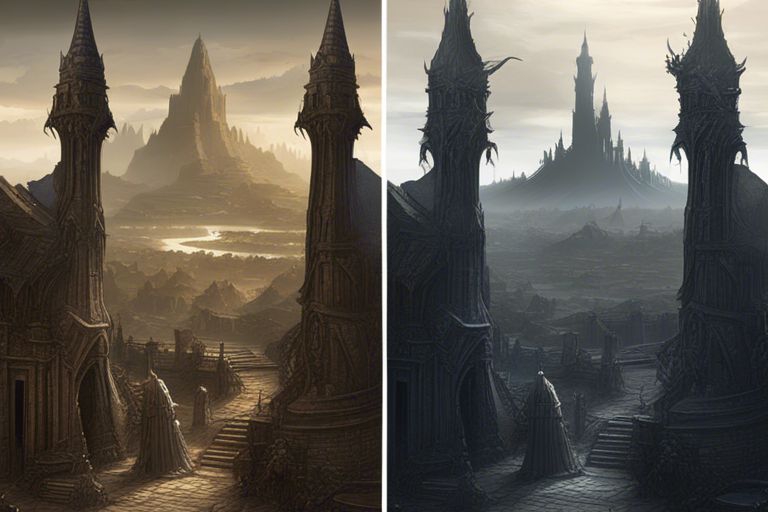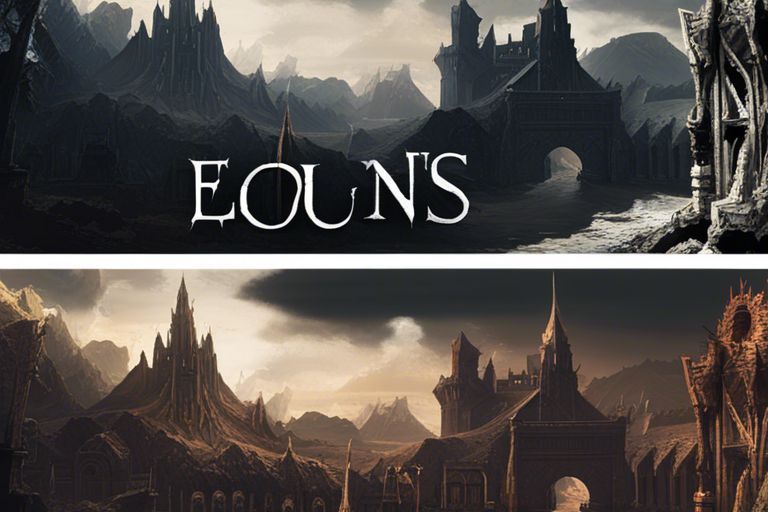Most gamers know that FromSoftware has solidified its reputation in the gaming world with its challenging and immersive action RPGs, with titles like “Dark Souls” becoming iconic in the industry. Now, with the release of “Elden Ring,” many fans are comparing the two epics to determine which reigns supreme. In this blog post, we will probe into the key differences and similarities between “Elden Ring” and “Dark Souls,” exploring what makes each game unique and appealing to players. If you’re a fan of the Soulsborne series or looking to probe into these deeply atmospheric and punishing worlds, this comparison will provide valuable insights to help you decide where to focus your gaming hours. For a detailed breakdown of the ranking of all the Souls games by FromSoftware, including “Elden Ring,” check out The Souls games by FromSoftware ranked, including ‘Elden Ring’.
Key Takeaways:
- Open-world vs semi-linear: “Elden Ring” offers a vast open-world to explore compared to the more confined environments in the “Dark Souls” series.
- Mounts and traversal: The addition of mounts in “Elden Ring” provides players with a new way to navigate the expansive world, unlike the limited movement options in “Dark Souls”.
- Dynamic weather and day/night cycle: “Elden Ring” features dynamic weather systems and a day/night cycle, enhancing immersion and strategical decisions in comparison to the static environments in “Dark Souls”.
- Increased focus on storytelling: “Elden Ring” places a stronger emphasis on narrative and world-building, offering a more interconnected story compared to the cryptic lore in “Dark Souls”.
- Greater build customization: “Elden Ring” provides more options for character customization and build variety, offering players a broader range of playstyles compared to the more limited builds in “Dark Souls”.
- Multiplayer mechanics: The multiplayer aspects in “Elden Ring” are more seamless and integrated, allowing for enhanced cooperative and competitive play experiences compared to the more isolated multiplayer features in “Dark Souls”.
- World design and exploration: While both games feature intricate level design, “Elden Ring” encourages more exploration and discovery through its open-world structure, offering players a sense of freedom and adventure not present in the more linear paths of “Dark Souls”.
Game Design and Mechanics
Core Gameplay Differences
Even though both “Elden Ring” and “Dark Souls” come from the same developer, they have distinct core gameplay differences that set them apart. An example lies in the open-world structure of “Elden Ring,” where players can explore vast landscapes on horseback, offering a sense of freedom unseen in the more linear world of “Dark Souls.” Combat in “Elden Ring” also introduces mounted combat, adding a new layer of strategy to engagements.
Level and World Design Philosophies
Even though both games are known for their intricate level and world design, any player venturing into the worlds of “Elden Ring” and “Dark Souls” will notice differences in their design philosophies. “Elden Ring” emphasizes a seamless open world with diverse biomes, encouraging exploration and discovery around every corner. On the other hand, “Dark Souls” focuses on interconnected level design, where shortcuts and hidden paths create a sense of verticality and interconnectedness.
For instance, the level design in “Elden Ring” utilizes vast open landscapes and verticality to encourage players to traverse the world in various ways, from climbing mountains to swimming through lakes. This design philosophy can lead to exciting discoveries but also presents challenges as players navigate the expansive world.

“Narrative and Immersion”
Storytelling Approaches in “Elden Ring” and “Dark Souls”
Clearly, FromSoftware has established itself as a master of weaving intricate, mysterious, and deep narratives in its games, particularly in the “Elden Ring” and “Dark Souls” series. Both games employ a unique storytelling approach that relies heavily on environmental storytelling, item descriptions, and cryptic NPC interactions to slowly unveil the lore of their worlds.
Impact on Player Engagement and Experience
Player immersion is a crucial aspect of both “Elden Ring” and “Dark Souls,” as the enigmatic storytelling prompts players to actively engage with the game world to uncover its secrets and lore. The cryptic nature of the narratives challenges players to piece together the story themselves, enhancing their sense of discovery and accomplishment.
Experience: The non-linear narrative structure of both games allows players to explore the vast, interconnected worlds at their own pace, creating a sense of freedom and agency. However, this approach can also be daunting for some players, as the lack of clear direction may lead to confusion and frustration. Nevertheless, the satisfaction of uncovering hidden stories and piecing together the lore is immensely rewarding, keeping players deeply engrossed in the intricate narratives.
Difficulty and Accessibility
Challenge Levels and Learning Curves
The difficulty in FromSoftware’s games has always been a defining feature, and “Elden Ring” and “Dark Souls” are no exceptions. The learning curve is steep, demanding that players adapt to the punishing combat mechanics and learn from their mistakes. The challenge levels escalate as players progress through the game, with each boss encounter proving to be a formidable test of skill and perseverance.
Player Agency and Difficulty Options
Any discussion about difficulty in FromSoftware’s games inevitably leads to the topic of player agency and difficulty options. While the studio is known for its unforgiving gameplay, it has made strides in recent years to provide players with more choices in how they approach the challenges presented. “Elden Ring” offers a variety of gameplay settings and accessibility features that allow players to tailor their experience to suit their skill level.
Difficulty options in “Elden Ring” and “Dark Souls” can range from traditional difficulty settings to more nuanced features like adjustable enemy aggression levels and the ability to summon AI companions to aid in battles. These options not only cater to a wider audience of players but also add a layer of depth to the gameplay experience, allowing for greater customization and personalization.
Visuals and Atmosphere
Not only are “Elden Ring” and “Dark Souls” both renowned for their atmospheric worlds, but they also excel in their visuals, drawing players in with stunning landscapes and intricate details.
Artistic Style and Graphics
Style-wise, both games showcase FromSoftware’s signature dark and gothic aesthetic. However, “Elden Ring” takes it a step further with its vast open-world environments and enhanced graphics, creating a more immersive experience for players.
Sound Design and Score
An crucial element in both games, the sound design and score play a crucial role in setting the eerie and intense tone of the gameplay. From the unsettling ambient noises to the epic orchestral scores, players are fully immersed in the ominous and thrilling atmosphere of these worlds.
It’s the careful attention to detail in the soundscapes and music that elevates the overall experience, making every encounter with enemies or exploration of new areas a memorable and engaging moment for players.
Cultural Impact and Legacy
Community Reception and Critic Reviews
To truly gauge the impact of “Elden Ring” and “Dark Souls” on the gaming landscape, one must look at the community reception and critic reviews of these monumental titles. Both games have garnered widespread acclaim from players and critics alike for their innovative gameplay mechanics, intricate world-building, and challenging difficulty levels. The devoted fan base of FromSoftware’s titles continues to grow, cementing their status as modern classics in the gaming industry.
Influence on the Gaming Industry and Pop Culture
Gaming historians and industry experts have noted the profound influence “Elden Ring” and “Dark Souls” have had on the gaming industry and pop culture at large. FromSoftware’s unique approach to game design, emphasizing player skill and exploration, has inspired a new wave of game developers to create challenging and immersive experiences. The distinct art style and dark fantasy themes of these games have also left a lasting mark on popular culture, influencing everything from art to literature.
Culture: The legacy of “Elden Ring” and “Dark Souls” extends beyond gaming, as these titles have become synonymous with a new era of challenging and rewarding gameplay experiences. Their impact on popular culture can be seen in the proliferation of memes, fan art, and discussions that continue to thrive online. The games have also sparked debates around the importance of difficulty in games and the role of storytelling in interactive experiences.
Summing up
Taking this into account, it is evident that “Elden Ring” and “Dark Souls” are both exceptional masterpieces created by FromSoftware, each with its own unique elements that cater to different types of players. While “Dark Souls” is revered for its challenging gameplay and intricate world-building, “Elden Ring” expands on these aspects with a more open-world approach and a deeper emphasis on exploration and narrative. Both games share the signature FromSoftware difficulty and dark fantasy themes, making them stand out in action RPGs. Whether you prefer the structured challenge of “Dark Souls” or the open-ended exploration of “Elden Ring,” both titles offer an immersive and unforgettable experience that solidifies FromSoftware’s reputation as one of the greatest game developers in the industry.
FAQ
Q: What is “Elden Ring”?
A: “Elden Ring” is an upcoming action role-playing game developed by FromSoftware in collaboration with George R. R. Martin, known for his work on the “Game of Thrones” book series.
Q: What is “Dark Souls”?
A: “Dark Souls” is a famous action role-playing game series developed by FromSoftware known for its challenging gameplay, intricate world design, and deep lore.
Q: How does “Elden Ring” compare to “Dark Souls” in terms of gameplay?
A: “Elden Ring” is expected to have similar gameplay elements to “Dark Souls,” such as challenging combat, exploration-driven progression, and a dark fantasy world. However, “Elden Ring” is said to offer a more open-world experience with horseback riding and a larger game world.
Q: What are the differences in the world design between “Elden Ring” and “Dark Souls”?
A: While both games feature dark fantasy worlds with interconnected environments, “Elden Ring” is expected to have a more expansive open-world design with a greater emphasis on exploration and discovery compared to the more linear level design of “Dark Souls.”
Q: How does the story and lore of “Elden Ring” compare to “Dark Souls”?
A: Both “Elden Ring” and “Dark Souls” are known for their deep, intricate lore and storytelling. However, with George R. R. Martin’s involvement in “Elden Ring,” players can expect a richer and more detailed narrative compared to the cryptic storytelling of the “Dark Souls” series.
Q: Are there any new gameplay mechanics introduced in “Elden Ring” that differentiate it from “Dark Souls”?
A: “Elden Ring” introduces new mechanics such as horseback riding for faster traversal, as well as a dynamic weather and time-of-day system that can affect gameplay. These additions add a new dimension to the gameplay experience compared to the more traditional mechanics of the “Dark Souls” series.
Q: In terms of difficulty, how does “Elden Ring” compare to “Dark Souls”?
A: Both “Elden Ring” and “Dark Souls” are known for their challenging difficulty levels. While “Elden Ring” is expected to maintain a similar level of challenge, the open-world nature of the game may offer players more options for approaching difficult encounters and exploring strategies compared to the more confined level design of “Dark Souls.”
